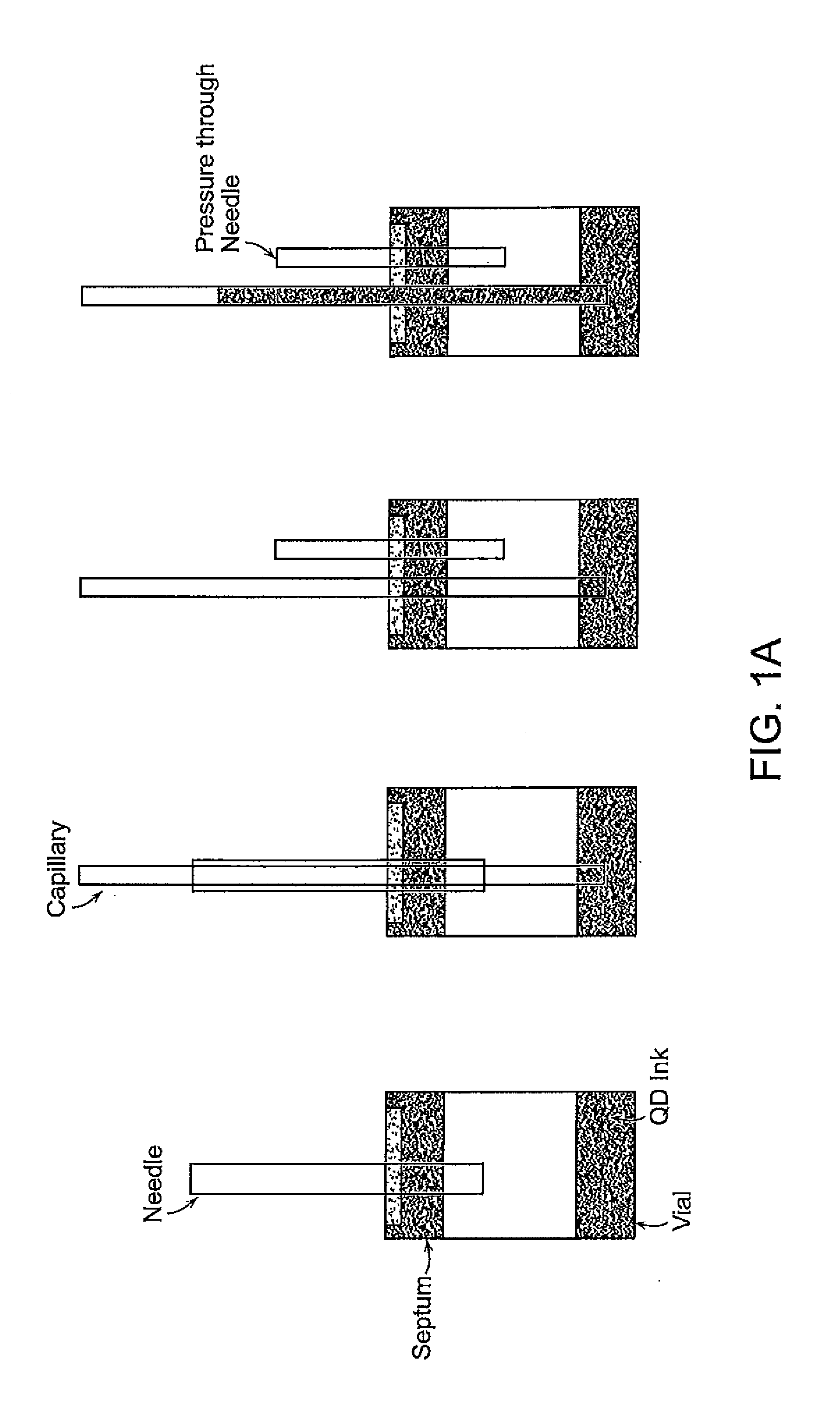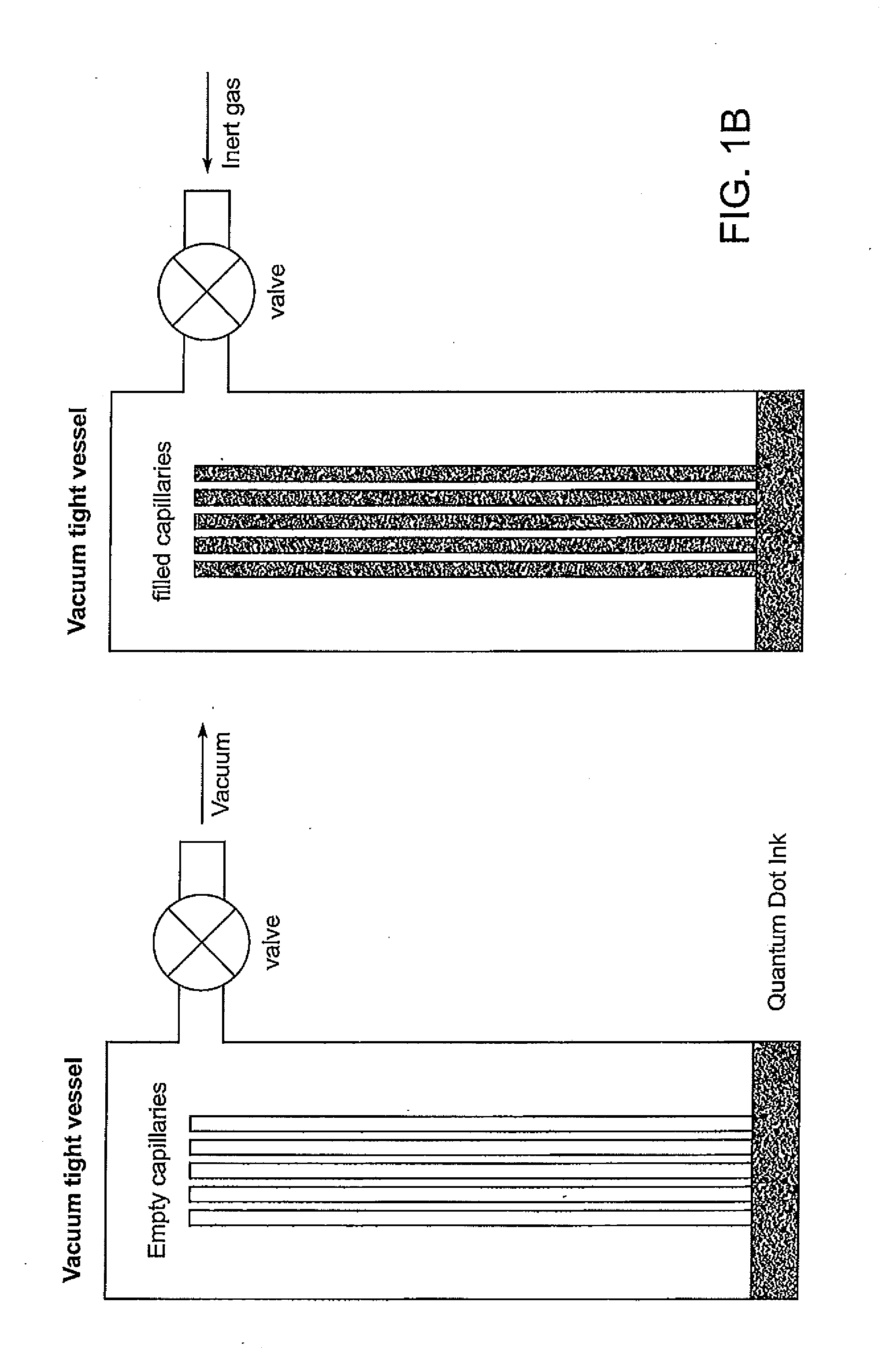Quantum dot based lighting
- Summary
- Abstract
- Description
- Claims
- Application Information
AI Technical Summary
Benefits of technology
Problems solved by technology
Method used
Image
Examples
example 1
A Trichromatic White Light Source Using a Blue LED and a Mixture of Red and Green Quantum Dots
[0117]A trichromatic white light source was created using film, as described below, including green quantum dots with a peak center wavelength of 523 nm and a FWHM of 37 nm, red quantum dots with a peak center wavelength of 617 nm and a FWHM of 32 nm, and a blue LED with a peak emission around 450 nm, arranged in a direct lit configuration. Blue light from the LED was used to excite a mixture of the green and red quantum dots. The emission spectra of the quantum dot mixture along with the spectra of the control white LED source are shown in FIG. 2. (The control white LED source is Sharp Microelectronics, Manufacturer Part No. GM5BW97333A (Description: LED White 115000K 20 MA 3.2V PLCC4)
[0118]The red and green quantum dots were prepared generally in accordance with the following procedures:
Preparation of Semiconductor Nanocrystals Capable of Emitting Green Light
[0119]Synthesis of ZnSe Cores:...
example 2
Backlight Units Using a Blue LED and a Mixture of Red and Green Quantum Dots
[0133]In accordance with certain embodiments of the disclosure, backlight units are provided which utilize quantum dots to generate trichromatic white light for transmission into and through a light guide. The backlight units provide a higher color gamut and better power efficiency compared to white LEDs. The quantum dots may be present in a film having dimensions similar to the face of a light guide and adjacent thereto or they may be present in a capillary or other vessel with dimensions similar to an edge of a light guide and adjacent thereto. Light generated by quantum dots as described herein can be transmitted through an edge of a light guide or a face of a light guide. According to one embodiment utilizing a quantum dot film shown in FIG. 6, a quantum dot backlight unit stack is depicted in which light from an LED source (shown here as a blue LED source with a light guiding reflection sheet) is positi...
example 3
General Method of Creating Trichromatic White Light Using a Blue LED and a Mixture of Red and Green Quantum Dots
[0139]A strip of blue LEDs is provided in a backlight. The preferred peak center wavelength of the blue LEDs is 450+ / −5 nm. Increasing the blue wavelength beyond 460 nm reduces the color gamut as blue light from the LED leaks into the green channel.
[0140]A mixture of green and red quantum dots mixed in an appropriate ratio is provided through an optic or a film. In the case of an optic, the optic is inserted between the LED and the light guide film or plate. In the case of film, it is inserted as a part of the optical film stack. The description of the optical film stack in case of edge optic is shown in FIG. 13.
[0141]The ratio of green to red quantum dots is selected to achieve the desired front of screen color point. In certain embodiment, ratios of weight percent Green to Red quantum dots can vary, for example, from about 3.5:1 to about 5.5:1. FIG. 12 shows the spectral...
PUM
 Login to View More
Login to View More Abstract
Description
Claims
Application Information
 Login to View More
Login to View More - R&D
- Intellectual Property
- Life Sciences
- Materials
- Tech Scout
- Unparalleled Data Quality
- Higher Quality Content
- 60% Fewer Hallucinations
Browse by: Latest US Patents, China's latest patents, Technical Efficacy Thesaurus, Application Domain, Technology Topic, Popular Technical Reports.
© 2025 PatSnap. All rights reserved.Legal|Privacy policy|Modern Slavery Act Transparency Statement|Sitemap|About US| Contact US: help@patsnap.com



